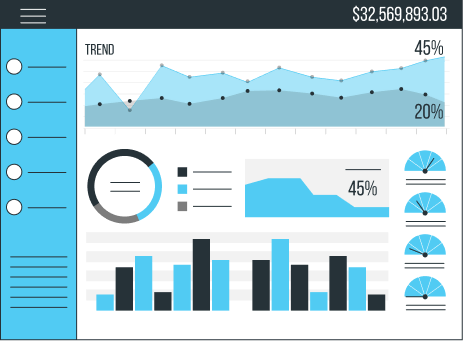In the course of a decade, SEMrush has become one of the most popular tools in the digital marketing world. At first, it was simply designed to be a simple keyword analysis solution; but in time, it became a true marketing tool directed to SEO professionals.

Its success is undeniable: today SEMrush is used by more than 6 million people in more than a hundred countries.
One of the most appreciated features with SEO consultants is the possibility to collect data that is essential to implementing a pertinent optimisation strategy (search volume for specific keywords, competitiveness, estimations on organic traffic generated by searches on a certain period of time…).
But that’s not the only advantage that SEMrush offers in terms of SEO! Other features are just as crucial to those working to boost the ranking of web pages.
SEMrush: the SEO tool now an “all-in-one marketing tool”
At the start, there was a simple SEO tool entitled Seodigger, created by Oleg Shchegolev and Dmitry Melnikov, which then became an extension of the Firefox browser. The idea is a simple as this: making sure that the competition around digital visibility remains transparent and fair, in order to offer the same chances to anyone who wishes to put their website in the top ranking numbers. In that spirit, SeoQuake Company became SEMrush in 2008.

Passionate about SEO, the two founders wanted to create a tool that would allow the identification of market trends and the best practices of internet professionals. From there, the news spread by word of mouth and allowed the tool to flourish. In 2016, the number of users crossed the million threshold and in 2020 it increased to 6 million. Multinationals such as eBay, Booking or BNP Paribas use it on a daily basis.
SEMrush’s place in the SEO landscape
To understand SEMrush’s place in the Search Engine Optimization landscape, it is first important to have a clear idea of what is that landscape. SEO is a fierce competition where all the participants hope to place their websites among the first places of search engine results pages – SERP. This is a prerequisite to generate qualified traffic and thus acquire new clients. The challenge is twofold: it has to both prove itself useful to internet users and satisfy the algorithms of the search engines. One cannot go without the other.

In order to achieve that, it is essential to apply a particular methodology: the SEO technique. It is based on several ideas: a complete audit to benefit from strategic recommendations (internal analysis and competitive intelligence), a quality and SEO-friendly content writing, the distribution of this content on the right media (social media especially), a follow-up on performances, etc. That is the methodology shared by SEO professionals, that is to say: SEO consultants. To do so, they have to use adapted and efficient tools.
Chosen by most SEO experts, SEMrush is the most complete and practical tool kit on the market. It includes many features to adopt this methodology and develop a relevant optimisation strategy while using a maximum of information. This explains why the tool is regularly awarded and mentioned among the best digital solutions. But what are these SEO features exactly?
Top 5 SEO features of SEMrush
Among these features that make SEMrush a thorough tool kit, here are those essential to SEO consultants.
1. DATA HARVESTING
SEMrush has a huge data base crucial to the implementing of a relevant SEO strategy. The tool transforms huge search volumes related to web traffic and to internet user behavior, to present them under the form of charts and graphics from which it is possible to extract key information. Here are some of the most useful examples:
- Ranking keywords of a website (on a given date and period).
- The webpages responding to those keywords.
- The search volumes associated.
- The ranking of given webpages (Top 5, 10 or 20).
- The competitiveness of the requests and the degree of difficulty estimated to rank higher.
- The types of content highlighted by search engines on these requests.
- The number and the nature of the backlinks.
- Etc.
This information supplied by SEMrush establish the foundation on which a SEO strategy can be build. The information is used in the context of a SEO audit to overview what has been done (precise keywords, quality of the optimisation, technical performances, number of backlinks…) as well as to benefit from recommendations, especially in terms of words and key expressions to work on in order to rank the webpages of the website in the Top 3 of Google’s other search engines SERPs.
2. COMPREHENSIVE AND AUTOMATED SEO REPORTING
The other SEO purpose of SEMrush has to do with what we call “Rank Tracking”, the precise follow-up of a website’s ranking. SEMrush gives access to a high range of related features of which a “SEO Toolkit” allowing to edit detailed reports. These reports are essential to a SEO consultant’s daily work because they help them evaluate the relevance of their actions and the performance of the operations.
Thanks to this feature, one can…
- Implement an automated tracking of ranking keywords in a website, in order to register the increases and the decreases in the ranking – and, if that is the case, to act without delay to bounce back.
- Compare webpages’ ranking according to several factors. For example, the type of medium used to access to the Internet (SERPs comparison on desktop and mobile phones).
- Automate backlinks’ audits, the famous “inbound links” very much decisive in an SEO strategy, especially for netlinking.
- Edit audit reports to monitor the health of a website in terms of its technical performances, of its explorability or even its security.
- Edit comprehensive reports concerning the selection of competitors – which we call the “Competitors Discovery” – and assess the chances for a website to rank for specific keywords or to win a Featured Snippet at the expense of a rival that already occupies that space (for example, a Position Zero).
So many reports that allow a consultant to adjust their SEO strategy in real time and activate the proper lever systems.
3. SEO COMPETITION ANALYSIS
It is common knowledge: Search Engine Optimization is a very competitive sector. Ranking a webpage on a given request comes down to bypassing a certain number of rival webpages already occupying the first ranks.
A good analysis of market trends and competing positions is primary to developing proper SEO strategies; and that is precisely what SEMrush allows to do thanks to its competitor discovering feature.
This feature offers the opportunity to analyze the websites of direct competitors and to compare them with a reference site for which we wish to improve the ranking (in terms of semantic similarities, inbound links, effectiveness in social advertising…), and to implement relevant strategies to conquer top rankings. You simply have to enter the URLs of the desired website to get an overview of the strategies used.

In detail, SEMrush analyzes:
- Traffic generated by competitors on chosen requests (the most effective keywords, changes in position over time, etc).
- Market trends.
- Ranking of competing sites for comparison purposes.
- Jointly worked keywords and opportunities related to less competitive requests.
- The distribution of referent areas (authority score).
- Backlinks (total number, monthly evolution with gained or lost links, distribution of anchors and links…).
- SEA performances (keywords associated with paid searches, display volume and text ads, products displayed on Google Shopping, etc.).
- The competitors’ content performance and the effectiveness of their distribution channels.
- The competitors’ social accounts performance (number of interactions, engagement generated, etc.).
This SEMrush feature is not just about spying: it also develops SEO strategies with a precise knowledge of what competitors are already doing and which market opportunities to explore, either by building on what already exists, or by imagining other strategies (e.g. focusing on long tail keywords), or by combining the two approaches.
4. CENTRALIZED MANAGEMENT OF SOCIAL NETWORKS
The growing importance of external SEO levers forces consultants to increasingly take into account social networks and their place within optimisation strategies.
Even if the impact of social platforms concerning organic SEO is indirect, these form nevertheless a significant source of traffic and a way to diversify acquisition channels (the CL Journal says that 12% of global web traffic is generated by social media).
Consequently, SEMrush has come up with a toolkit to centralize the management of these platforms from a single interface. Thus, the Social Media Toolkit allows to…
- Schedule posts in advance, in order to reach the target audience at the right time (including on nights and weekends).
- Monitor posts performance in terms of interactions and engagement (likes, comments, shares…).
- Watch over the activity of social accounts managed by competitors.

To do so, SEMrush has developed two tools designed to assist SEO consultants and community managers:
The Social Media Poster which allows you to write, schedule and publish content without leaving the SEMrush interface (available on Facebook, Twitter, Instagram and Pinterest).
The Social Media Tracker which includes all the tools that allow you to monitor your social accounts as well as your competitors’ by comparing engagement levels, identifying the content that hits the high marks, etc.
5. CREATION OF QUALITY AND SEO-FRIENDLY CONTENT
There are about 200 ranking criteria in SEO. A good third of these criteria are content alone. Meaning that creating optimized content is a constant challenge for SEO consultants.
SEMrush understands this and offers a proper feature: a complete workflow system for creating SEO-compliant content – in other words, SEO-friendly content.
This feature gives access to tools that allow you to…
- Find content ideas (Topic Research) from given keywords and topics.
- Identify subjects that catch users’ interest, related to a given theme or sector of activity.
- Create compelling headlines that capture Internet users’ attention (based on successful examples).
- Identify competitive strategies that give the best results, in order to find inspiration.
- Optimize the contents by drawing from the best SEO practices.
- Verify that the content has been properly optimized based on the recommendations made by SEMrush.
- Measure the impact of the content on the ranking of the pages for targeted keywords.
These metrics are used to monitor the performance of a content strategy (for SEO purposes), but also to enhance the value of an internal content marketing approach by showing results in the SERPs ranking. However, be aware that: SEMrush is of great help, but does not write the content!
As you can see, SEMrush’s assets go far beyond the collection of keywords and the evaluation of search volumes.

It is a thorough tool that is essential for SEO consultants, but also for anyone who wants to develop relevant and effective marketing strategies.












